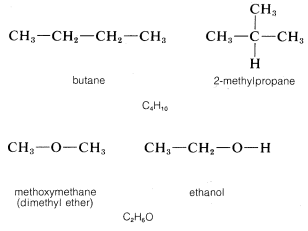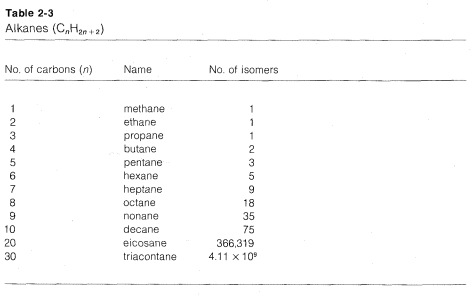4.20: 4-4 Alkanes and Alkane Isomers
- Page ID
- 91981
Objectives
After completing this section, you should be able to
- draw the Kekulé structure, condensed structure and shorthand structure of each of the first ten straight-chain alkanes.
- name each of the first ten straight-chain alkanes, given its molecular formula, Kekulé structure, condensed structure or shorthand structure.
- explain the difference in structure between a straight- and a branched-chain alkane, and illustrate the difference using a suitable example.
- explain why the number of possible isomers for a given molecular formula increases as the number of carbon atoms increases.
- draw all the possible isomers that correspond to a given molecular formula of the type Cn H2n+2, where n is ≤ 7.
Key Terms
Make certain that you can define, and use in context, the key terms below.
- branched-chain alkane
- constitutional or structural isomer
- homologous series
- isomer
- saturated hydrocarbon
- straight-chain alkane (or normal alkane)
Study Notes
A series of compounds in which successive members differ from one another by a CH2 unit is called a homologous series. Thus, the series CH4, C2H6, C3H8 . . . CnH2n+2, is an example of a homologous series.
It is important that you commit to memory the names of the first 10 straight-chain alkanes (i.e., from CH4 to C10H22). You will use these names repeatedly when you begin to learn how to derive the systematic names of a large variety of organic compounds. You need not remember the number of isomers possible for alkanes containing more than seven carbon atoms. Such information is available in reference books when it is needed. When drawing isomers, be careful not to deceive yourself into thinking that you can draw more isomers than you are supposed to be able to. Remember that it is possible to draw each isomer in several different ways and you may inadvertently count the same isomer more than once.
Alkanes are organic compounds that consist entirely of single-bonded carbon and hydrogen atoms and lack any other functional groups. Alkanes have the general formula \(C_nH_{2n+2}\) and can be subdivided into the following three groups: the linear straight-chain alkanes, branched alkanes, and cycloalkanes. Alkanes are also saturated hydrocarbons.
Cycloalkanes are cyclic hydrocarbons, meaning that the carbons of the molecule are arranged in the form of a ring. Cycloalkanes are also saturated, meaning that all of the carbons atoms that make up the ring are single bonded to other atoms (no double or triple bonds). There are also polycyclic alkanes, which are molecules that contain two or more cycloalkanes that are joined, forming multiple rings.
This is an introductory page about alkanes, such as methane, ethane, propane, butane and the remainder of the common alkanes. This page addresses their formulae and isomerism, their physical properties, and an introduction to their chemical reactivity.
Molecular Formulas
Alkanes are the simplest family of hydrocarbons - compounds containing carbon and hydrogen only. Alkanes only contain carbon-hydrogen bonds and carbon-carbon single bonds. The first six alkanes are as follows:
| methane | CH4 |
| ethane | C2H6 |
| propane | C3H8 |
| butane | C4H10 |
| pentane | C5H12 |
| hexane | C6H14 |
You can work out the formula of any of the alkanes using the general formula CnH2n+2
Isomerism
All of the alkanes containing 4 or more carbon atoms show structural isomerism, meaning that there are two or more different structural formulae that you can draw for each molecular formula.
Example: Butane or MethylPropane
C4H10 could be either of these two different molecules:

These are named butane and 2-methylpropane, respectively
What is structural isomerism?
Isomers are molecules that have the same molecular formula, but have a different arrangement of the atoms in space. That excludes any different arrangements which are simply due to the molecule rotating as a whole, or rotating about particular bonds. For example, both of the following are the same molecule. They are not isomers; both are butane.
There are also endless other possible ways that this molecule could twist itself. There is completely free rotation around all the carbon-carbon single bonds. If you had a model of a molecule in front of you, you would have to take it to pieces and rebuild it if you wanted to make an isomer of that molecule. If you can make an apparently different molecule just by rotating single bonds, it's not different - it's still the same molecule.
In structural isomerism, the atoms are arranged in a completely different order. This is easier to see with specific examples. What follows looks at some of the ways that structural isomers can arise. The names of the various forms of structural isomerism probably do not matter all that much, but you must be aware of the different possibilities when you come to draw isomers.
Chain isomerism
These isomers arise because of the possibility of branching in carbon chains. For example, there are two isomers of butane, C4H10. In one of them, the carbon atoms lie in a "straight chain" whereas in the other the chain is branched.
Be careful not to draw "false" isomers which are just twisted versions of the original molecule. For example, this structure is just the straight chain version of butane rotated about the central carbon-carbon bond.
You could easily see this with a model. This is the example we've already used at the top of this page.
Example \(\PageIndex{1}\): Chain Isomers in Pentane
Pentane, C5H12, has three chain isomers. If you think you can find any others, they are simply twisted versions of the ones below. If in doubt make some models.
Isomerization in Organic Compounds
-
- Last updated
- 20:15, 31 Mar 2016 by Michael Cosgrove
-
- Page restriction
- Public
More than one stable substance can correspond to a given molecular formula. Examples are butane and 2-methylpropane (isobutane), each of which has the molecular formula C4H10C4H10. Similarly, methoxymethane (dimethyl ether) and ethanol have the same formula, C2H6OC2H6O:

Compounds having the same number and kinds of atoms are called isomers.22 Whereas only one stable substance is known corresponding to the formula CH4CH4, thirty-five stable isomers have been prepared of the formula C9H20C9H20. From this one may begin to sense the rich variety of organic chemistry, which leads to many problems - in telling one compound from another, in determining structures, and also in finding suitable names for compounds. In the rest of this chapter we will describe one type of isomer - the position isomer - and in later chapters we will discuss another type of isomer - the stereoisomer - and the experimental approaches that are used to establish the purity, identity, structure, and stereochemistry of organic compounds.
Position Isomers
Compounds having the same number and kind of atoms but having different bonding arrangements between the atoms are called position isomers. Butane and 2-methylpropane are examples of position isomers. The atoms are connected differently in the two structures because the carbon chain in butane is a straight or continuous chain, whereas in 2-methylpropane it is branched:

Therefore these two molecules are structurally different and, accordingly, do not have the same chemical and physical properties. They cannot be converted one into the other without breaking and remaking C−CC−C and C−HC−H bonds. Methoxymethane and ethanol are also position isomers because the oxygen clearly is connected differently in the two molecules:

The term position isomer means the same as constitutional isomer. The designation structural isomer also is used, but this term is taken by some to include both position isomers and stereoisomers; that is, "structure" can mean both the way in which atoms are connected and their different arrangements in space.
The number of position isomers possible for a given formula rapidly increases with the increasing number of carbon atoms, as can be seen from the number of theoretically possible structures of formula CnH2n+2CnH2n+2 up to n=10n=10 given in Table 2-3. In 1946, it was reported that all of the 75 compounds with values of n=1n=1 to n=9n=9 had been prepared in the laboratory. Before we can begin to discuss the chemistry of these compounds it is necessary to know how

to name them; without convenient and systematic rules for nomenclature that are adopted universally, catastrophic confusion would result. We shall tackle this problem in the next chapter.
22The prefix iso is from the Greek word meaning the same or alike.
Contributors
- John D. Robert and Marjorie C. Caserio (1977) Basic Principles of Organic Chemistry, second edition. W. A. Benjamin, Inc. , Menlo Park, CA. ISBN 0-8053-8329-8. This content is copyrighted under the following conditions, "You are granted permission for individual, educational, research and non-commercial reproduction, distribution, display and performance of this work in any format."
Exercises
Contributors
Dr. Dietmar Kennepohl FCIC (Professor of Chemistry, Athabasca University)
Prof. Steven Farmer (Sonoma State University)
Organic Chemistry With a Biological Emphasis by Tim Soderberg (University of Minnesota, Morris)

